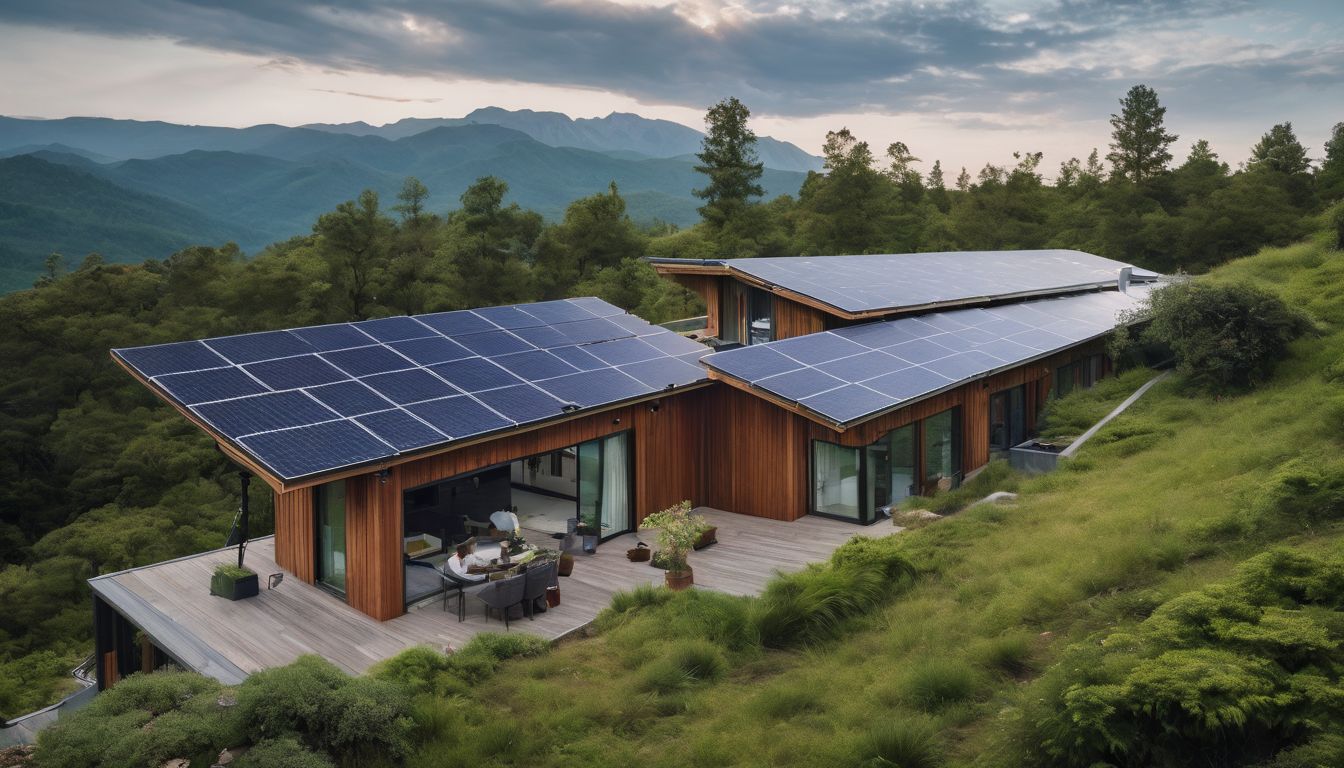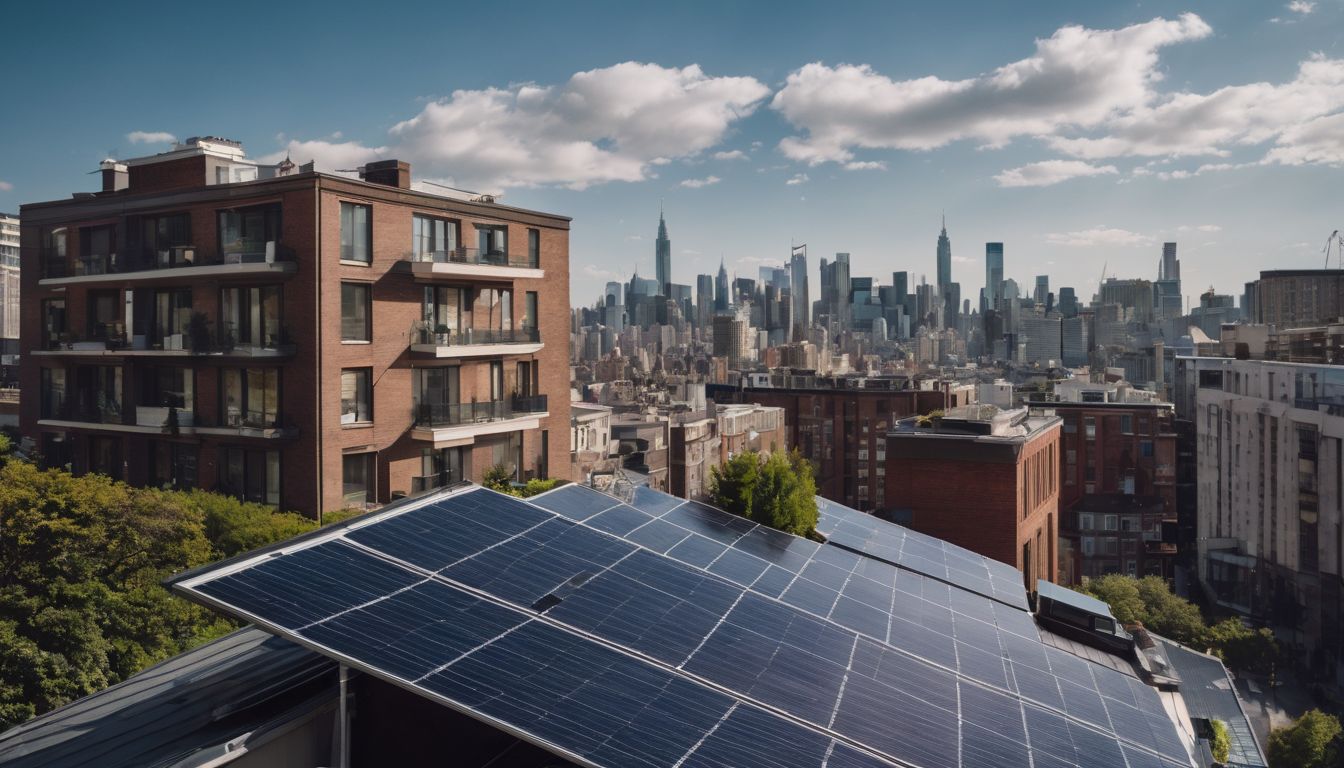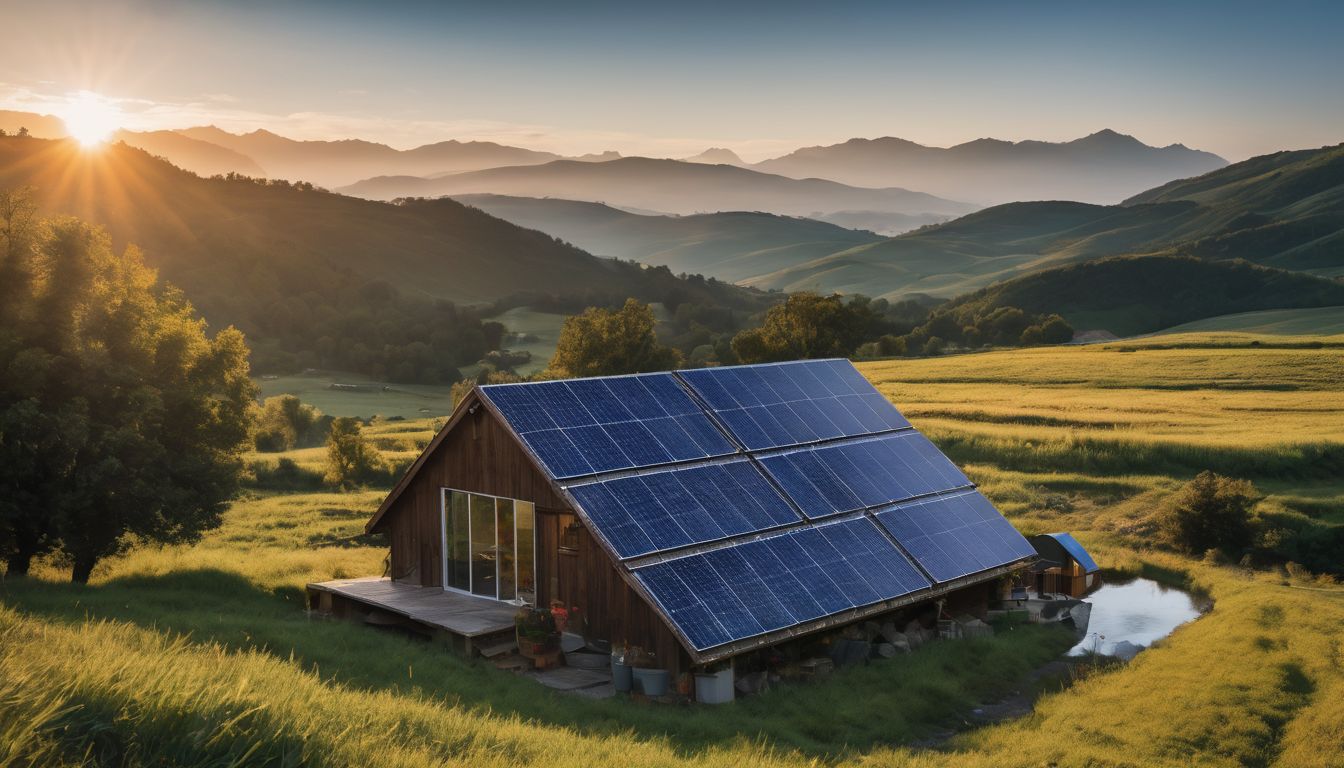As we all look for ways to power our lives without harming the planet, storing solar energy has become a big talking point. An impressive fact is that solar power could potentially supply over 40% of the world’s electricity by 2050.
This article shines a light on how advancements in storage technology could transform our sunny days into a steady stream of power, even when it’s dark. Discover the bright future of keeping energy from the sun!
Key Takeaways
- Solar energy storage systems (ESS) are becoming increasingly important for integrating renewable energy into power grids, providing benefits like grid stabilisation and reducing peak demand.
- Different types of ESS include mechanical, electrochemical batteries, thermal storage, flywheels, superconducting magnetic energy storage, and supercapacitors. Each type offers unique advantages for clean and sustainable electricity use.
- Behind-the-meter applications empower homes and businesses to store solar power for later use, helping reduce electricity bills and increasing energy independence.
- The adoption levels of energy storage systems vary across the world with developed nations leading in innovation while emerging regions show growing interest due to environmental concerns and investment in renewables.
- Trends in the sector include integration with smart grids, demand response programmes, off-grid solutions for remote areas without grid access, microgrid development supporting localised generation/distribution of power and electrification of transportation.
Understanding Energy Storage Systems
Energy storage systems (ESS) come in various types and are crucial for storing excess energy. They are driven by the need for grid stabilisation, frequency regulation and renewable energy integration.
Before-the-meter applications include utility-scale projects while behind-the-meter applications can support homes or businesses.
Types of ESS
- Mechanical Energy Storage: This type stores energy in mechanical forms like elevated weights or compressed air. For example, pumped hydroelectric storage moves water between reservoirs at different heights, releasing energy as it flows downhill through turbines.
- Electrochemical Batteries: These are common in homes and businesses for solar storage; think lithium-ion or lead-acid batteries that store energy chemically and release it as electrical power when needed.
- Thermal Storage: This system captures heat energy, which can be used directly for heating or to generate electricity later on. Materials such as molten salt can hold immense amounts of heat from the sun.
- Flywheels: Flywheels spin at high speeds to store kinetic energy that can be quickly converted back into electricity. They are excellent for short-term stabilisation of the electric grid.
- Superconducting Magnetic Energy Storage: Uses magnetic fields created by supercooled coils to store electrical energy, releasing it with minimal loss when demand peaks.
- Supercapacitors: Also known as ultracapacitors, these store electrical charges statically on surfaces with rapid charge and discharge capabilities, suitable for short-term power boosts.
Key drivers for ESS
As we delve into exploring the key drivers for energy storage systems, it becomes clear that the increasing integration of renewable energy sources such as solar and wind power is a significant catalyst.
The shift towards cleaner and more sustainable energy solutions is propelling the demand for ESS, driven by the need to mitigate climate change impacts. Additionally, advancements in battery technology and declining costs are also driving the adoption of energy storage systems, offering improved efficiency in harnessing renewable energy.
The transition towards reducing reliance on fossil fuels has further propelled the development and implementation of ESS, supporting grid stability and enhancing overall energy resilience.
Applications: Before and behind the meter
Before-the-meter applications involve energy storage systems that are connected directly to the utility grid, supporting grid stability and reducing peak demand. These applications benefit entire communities by enhancing renewable energy integration and improving overall grid reliability.
Behind-the-meter applications, on the other hand, focus on individual or commercial properties, enabling them to store excess solar power for use during peak hours or when sunlight is not available.
This empowers consumers to manage their energy usage efficiently while also contributing to a more resilient and sustainable energy future.
Benefits of ESS
Before-the-meter applications involve utility-scale energy storage systems that help stabilise the grid and reduce peak demand, while behind-the-meter applications enable homeowners and businesses to store excess solar energy for use during non-sunny hours.
Before-the-meter applications
Before-the-meter applications involve the use of energy storage systems (ESS) at the utility level for grid stabilisation and peak shaving. They are essential for balancing supply and demand, reducing transmission congestion, and enhancing grid reliability.
- Utility-Scale Storage: Large-scale ESS installations at power plants or substations to store excess energy during off-peak hours for distribution during peak demand.
- Renewable Integration: Pairing ESS with large-scale solar and wind farms to manage intermittent renewable energy generation, ensuring a steady and reliable power supply.
- Ancillary Services: Providing frequency regulation, spinning reserves, and voltage support to maintain stable grid operations.
- Grid Resilience: Enhancing the resilience of the energy infrastructure by providing backup power during outages or natural disasters.
- Demand Response Programmes: Utilising ESS to reduce overall demand on the grid during peak periods, thus avoiding costly infrastructure upgrades.
Behind-the-meter applications
Behind-the-meter applications allow individuals and businesses to store excess solar energy for personal use. This includes:
- Powering homes and businesses during non-sunlight hours, reducing reliance on the grid.
- Providing emergency backup power during grid outages.
- Shifting peak energy demand to off-peak times, reducing electricity costs.
- Supporting grid stability and reliability by balancing supply and demand locally.
- Enabling greater energy independence and reducing carbon footprint through self-consumption of renewable energy.
State of the Art in the Energy Storage Sector
Energy storage systems have gained significant attention from various stakeholders, including utility companies, industrial sectors, and residential users. The regional penetration of these systems varies widely across different parts of the world.
Groups of interest and stakeholders
Stakeholders in the energy storage sector include utility companies, solar developers, battery manufacturers, policymakers, and consumers. Each group has a vested interest in advancing energy storage technology for various reasons such as improving grid reliability, increasing renewable energy integration, reducing carbon emissions and enhancing energy resilience.
These stakeholders play key roles in driving innovation and adoption of advanced energy storage systems to ensure a sustainable and efficient energy future.
Interest groups like environmental organisations also actively advocate for policies that support the development and deployment of clean energy technologies while raising awareness about the benefits of solar energy storage.
Regional penetration
The regional penetration of energy storage systems (ESS) varies significantly around the world. Developed countries are leading in the adoption and innovation, while developing nations are increasingly recognising the importance of energy storage.
| Region | Adoption Level | Key Factors |
|---|---|---|
| North America | High | Strong policy support, technological innovation |
| Europe | Moderate to High | Regulatory frameworks, renewable targets |
| Asia-Pacific | Variable | Rapid economic growth, increasing energy demand |
| Middle East & Africa | Emerging | Resource abundance, investment in renewables |
| Latin America | Emerging | Increasing interest in sustainable development |
Investment in ESS continues to grow as regions recognise the need for reliable and sustainable power. The environmental benefits offered by ESS encourage this growth. The discussion now moves to the five key application trends in the energy storage systems sector.
Trends in the Energy Storage Systems Sector
The energy storage systems sector is experiencing 5 key application trends that are shaping the future of renewable energy storage. From grid stability to off-grid solutions, these trends are driving innovation and advancements in the industry.
5 key application trends
Solar energy storage has witnessed several key application trends that are driving innovation and adoption in the sector:
- Integration with smart grids: Solar energy storage systems are increasingly being integrated with smart grid technology to enhance reliability and efficiency.
- Demand response programmes: The integration of solar energy storage with demand response programmes is enabling more efficient management of energy consumption and peak load reduction.
- Off-grid applications: Solar energy storage is gaining traction for off-grid applications, providing reliable and sustainable power in remote areas without access to traditional grid infrastructure.
- Microgrid development: Solar energy storage systems are playing a crucial role in the development of microgrids, improving resilience and enabling localised energy generation and distribution.
- Electrification of transportation: The advancement of solar energy storage technology is contributing to the electrification of transportation through the development of efficient and sustainable battery solutions for electric vehicles.
The Future of Solar Energy Storage
The future of solar energy storage is promising as advancements in battery technology and the potential of alternative energy storage systems continue to grow. With market growth projections on the rise, solar energy is set to play a crucial role in renewable energy and have a significant impact on climate change and energy resilience.
Role of solar in renewable energy
Solar energy plays a pivotal role in the realm of renewable energy, harnessing the power of sunlight to generate electricity through photovoltaic technology. Its impact on sustainable energy is profound, offering an environmentally-friendly alternative that reduces reliance on fossil fuels and contributes towards combating climate change.
As advancements in solar technology continue to drive down costs and improve efficiency, the market for solar energy storage is expected to experience significant growth, enhancing energy resilience and accelerating the transition towards a more sustainable future.
With its potential to revolutionise how we consume and store energy, solar power stands as a beacon of hope for those seeking innovative solutions that prioritise environmental conservation.
Market growth projections
As solar energy plays an increasingly significant role in renewable power generation, the market growth projections for energy storage systems are promising. The advancements in battery technology and the increasing focus on energy innovation are driving the rapid expansion of the battery market. Technological advancements and a shift towards renewable batteries are set to elevate energy efficiency to new heights, boosting the demand for energy storage solutions.
In addition, with a growing emphasis on environmental conservation and climate change resilience, there is potential for alternative energy storage systems to further revolutionise the industry. This ever-evolving landscape presents exciting opportunities for individuals supporting conservation and environmental sustainability, as they contribute to shaping a more sustainable future through their support of solar energy storage solutions.
Advancements in battery technology
Advancements in battery technology have revolutionised solar energy storage, making it more efficient and reliable than ever. The development of lithium-ion batteries has significantly improved the capacity and lifespan of energy storage systems, allowing for better integration with solar power generation.
Innovations such as solid-state batteries and flow batteries are also showing promising potential for enhancing the performance and sustainability of solar energy storage solutions.
As a result, environmentally conscious individuals can look forward to even greater opportunities to utilise renewable energy sources without compromising on reliability or efficiency.
Looking ahead, advancements in battery technology will continue to drive the growth of the solar energy market, offering improved options for sustainable power generation and helping to further mitigate climate change impacts.
Potential of alternative energy storage systems
As the demand for energy storage continues to grow, alternative energy storage systems are emerging as promising solutions. These systems have the potential to significantly impact the renewable energy landscape and contribute to environmental conservation.
- Hydrogen Energy Storage: Utilising hydrogen as an energy carrier offers a way to store renewable energy for long periods and deliver power when needed.
- Thermal Energy Storage: This method involves storing thermal energy in materials such as molten salt or phase change materials, allowing it to be used later to generate electricity.
- Compressed Air Energy Storage (CAES): CAES systems store excess electricity by compressing air into underground reservoirs, which can then be released to generate power when needed.
- Flywheel Energy Storage: This technology uses kinetic energy stored in a spinning flywheel to provide short bursts of power or maintain consistent output levels.
- Gravity-based Energy Storage: Systems like pumped hydroelectric storage and gravitational potential energy storage use elevation differences to store and release energy, providing reliable backup power for renewables.
Impact on climate change and energy resilience
Solar energy storage plays a crucial role in mitigating climate change by reducing reliance on fossil fuels and decreasing greenhouse gas emissions. The integration of solar energy with storage systems enhances energy resilience, enabling reliable power supply even during adverse weather conditions or grid outages.
By harnessing the potential of solar energy storage, individuals can actively contribute to environmental conservation and sustainability efforts while promoting cleaner and more resilient energy solutions.
The adoption of solar energy storage not only reduces carbon footprint but also supports the transition towards a more sustainable and eco-friendly future. It empowers environmentally conscious individuals to play an active role in combating climate change while ensuring a reliable and efficient energy supply for their communities.
Conclusion
In conclusion, solar energy storage holds great promise for the future. The market is projected to experience significant growth. Advancements in battery technology will play a crucial role in enhancing energy storage capabilities.
Alternative energy storage systems are also poised to make a meaningful impact on climate change and energy resilience. As we look ahead, the future of solar energy storage appears bright and full of potential.
FAQs
1. What does the future of solar energy storage look like?
The future of solar energy storage is promising, with advances in technology and battery market growth offering more efficient ways to store power from the sun.
2. Will there be improvements in how we store solar energy?
Yes, ongoing research and development are expected to bring about significant improvements in storing solar energy, making it more reliable and accessible for everyone.
3. Can we expect batteries to get better for storing solar power?
Absolutely! As the battery market grows, we can anticipate more powerful and longer-lasting batteries specifically designed for efficient solar energy storage.
4. How important is battery growth for the future of solar storage?
Battery growth is crucial because better batteries mean we can store more solar power when the sun is shining and then use this stored energy even when it’s not sunny.





